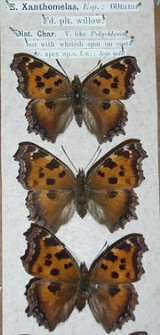
Nymphalis xanthomelas
Encyclopedia
The Scarce Tortoiseshell (Nymphalis xanthomelas) is a species of nymphalid
butterfly found in Asia
. This butterfly is also referred as Yellow-legged Tortoisehell or Large Tortoiseshell (however, in Europe, "Large Tortoiseshell" is usually reserved for Nymphalis polychloros
).
_i_img_7043.jpg) Underside dull ochraceous brown, the basal halt: of both fore and hind wings and a broad terminal margin darker brown; the wings entirely and thickly covered with slender transverse dark brown striae; irregular cell-marks on the fore wing and a transverse highly sinuous subterminal band of dark blue lunules on both wings: these lunules defined by slender black lines on both sides. Bases of the wings with a clothing of long stiff black hairs, which are blunt at their apices, and on the fore wing extend along the basal half of the costal margin, projecting outwards beyond it. Antennae, head and thorax very dark brown, abdomen fulvous; beneath very hairy; palpi, thorax and abdomen dark brown, the abdomen towards the apex paler.
Underside dull ochraceous brown, the basal halt: of both fore and hind wings and a broad terminal margin darker brown; the wings entirely and thickly covered with slender transverse dark brown striae; irregular cell-marks on the fore wing and a transverse highly sinuous subterminal band of dark blue lunules on both wings: these lunules defined by slender black lines on both sides. Bases of the wings with a clothing of long stiff black hairs, which are blunt at their apices, and on the fore wing extend along the basal half of the costal margin, projecting outwards beyond it. Antennae, head and thorax very dark brown, abdomen fulvous; beneath very hairy; palpi, thorax and abdomen dark brown, the abdomen towards the apex paler.
Wing expanse of 63–68 mm.
quoted in Bingham)
Nymphalidae
The Nymphalidae is a family of about 5,000 species of butterflies which are distributed throughout most of the world. These are usually medium sized to large butterflies. Most species have a reduced pair of forelegs and many hold their colourful wings flat when resting. They are also called...
butterfly found in Asia
Asia
Asia is the world's largest and most populous continent, located primarily in the eastern and northern hemispheres. It covers 8.7% of the Earth's total surface area and with approximately 3.879 billion people, it hosts 60% of the world's current human population...
. This butterfly is also referred as Yellow-legged Tortoisehell or Large Tortoiseshell (however, in Europe, "Large Tortoiseshell" is usually reserved for Nymphalis polychloros
Large Tortoiseshell
The Blackleg Tortoiseshell or Large Tortoiseshell is a butterfly of the family Nymphalidae. Although it looks very like the Small Tortoiseshell , it is more closely related to the Camberwell Beauty. It is now an extreme rarity in Britain, although it used to be widespread throughout England and...
).
Description
Upper side rich orange-yellow, Fore wing has costal margin dusky black on the basal half flecked with brown; two oval black spots in cell, a quadrate subcostal black patch just beyond the discocellulars, a second more oblique irregular black patch beyond this, and three large oval discal black spots, with a smaller dusky patch beyond the lowest spot. Hind wing uniform, with a large subcostal black patch. Fore and hind wings with a common sinuous transverse subterminal black band, and a terminal dusky band flecked with golden brown ; the black subterminal band on the hind wing with an outer border of blue lunules margined outwardly by a slender black line; the fore wing just below the costa, between the black patches beyond the cell and between the outer black patch and subterminal band, prominently pale yellow. In the female, an incomplete series of yellow lunules also borders the subterminal black band on the outer side._i_img_7043.jpg)
Wing expanse of 63–68 mm.
Life history
"Larva. Cylindrical, slightly hairy. Head subquadrate, vertex sharply indented in front, slightly hairy, front and cheeks with several small pointed tubercles. Third to last segments armed with a dorsal row of .short spines, and three lateral rows of long rigid branched spines. Colour dark pupurescent-brown, almost black, palest beneath; with two dorsal slender yellowish macular lines, and a single similar lateral line, the subdorsal and sublateral areas longitudinally speckled with numerous irregular-shaped yellow dots. Spines black; head black. Reared on willow." (Frederic MooreFrederic Moore
Frederic Moore FZS was a British entomologist. It has been said that Moore was born at 33 Bruton Street but may be incorrect given that this was the address of the menagerie and office of the Zoological Society of London from 1826 to 1836.Moore was appointed an assistant in the East India Company...
quoted in Bingham)
Larval host plants
- Celtis australisCeltis australisCeltis australis, commonly known as the European nettle tree, Mediterranean hackberry, lote tree, or honeyberry, is a deciduous tree that can grow 20 or 25 meters in height....
- Pistacia integerrimaPistacia integerrimaPistacia integerrima is a species of pistachio tree native to Asia. Its common names in Hindi include kakar singhi, kakra, and kakring. It is used for a variety of purposes in India, including timber, dye, and fodder...
- Salix elegans
- Salix excelsa

